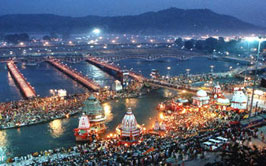History
Rishikesh Haridwar Uttaranchal
Rishikesh Haridwar

Haridwar is the place where people from across the India visit for pilgrimage and to take a holy dip into the holy river Ganges. Haridwar is an ancient city & it is one of the most sacred cities in India. The diverse nature of the Hindu religion has attracted foreign visitors from all around the world. Foreigners always attracted to Haridwar because here they can closely experience India's complex culture, various Hindu rituals and the ancient civilization.
Haridwar
30 kms from & 90 kms from & 220 kms from DelhiHaridwar is one of the primary areas where river Ganges emerges from the mountains & enters to the plain areas. Lush green forests and crystal clear water of river Ganges & background of mountains create the charming beauty of this holy city. In the evening ghats looks beautiful as hundreds of diyas (lamps) and marigold flowers float and light up the river Ganges. The Rajaji National Park is just 10 kms from Haridwar. Its an ideal destination for wild life and adventure lovers.
"Agar apne paap dhone hai to Haridwar mein Gangaji ki dubki lagao" (If you want to purify yourselves take a holy dip in the water of river Ganges at Haridwar. All your sins will be purified). This is most common thing which you can hear about Haridwar in all over India.
Haridwar contains two words Hari & Dwar. Hari means god & Dwar means gate. Haridwar means gateway to the god. There are four holy temples Gangotri, Yamunotri, Kedarnath & Badrinath on the hills also known as chardham. Haridwar is like a entry point to these chardham. People visit Haridwar before visiting these temples so the town was became famous as Haridwar. Shaivites call it Har Dwar Gateway to Lord Shiva (Kedarnath Temple) & Vaishnavites call it Hari Dwar Gateway to Lord Vishnu (Badrinath Temple) It is also said that Haridwar is blessed by the presence of all three major Gods of Hindus namely Brahma, Vishnu and Maheshwar. Thus, with all these mythological links attached to its name, it's little wonder why Haridwar is often referred to as 'gateway to god'.
Haridwar is an ancient pilgrimage site situated in the foothills of the shivalik range in Garhwal Himalayas. Haridwar is welcomes the river ganga to the plain areas. Haridwar means gurgling of river Ganges, innumerable temples, groups of monks in saffron clothes, enchanting sounds of vedic hymns & the divine holiness.
Apart from religious importance Haridwar is also a centre for learning different arts & culture. Haridwar is well known as great source of Ayurvedic medicines & herbal remedies. Haridwar is now home to unique Indian tradition of teaching “Gurukula.” Gurukula Kangri Vishwavidyalay is providing unique teaching in Gurukul system since 1902.
Haridwar is always place of interest for the researchers because it is one of the oldest living cities in India. Haridwar has numerous temples with interesting legacies. Maa Ganga after carrying the purity of heaven from the kamandal of Lord Brahma, washing the feet of Lord Vishnu and flowing through the sahastrara of Lord Shiva came on this earth and made Haridwar as it's divine flow area. From time immemorial, Maa Ganga has been doing the duty of absorbing the heat and negativities of this earth. Besides and , It is Gateway for the four dhams of Himalayas viz. Gangotri, Yamunotri,
Kedarnath and Badrinath.
Haridwar is divided in several small areas such as Mayapur, Ranipur, Jwalapur, Har Ki Pauri, Motichur, Devpura, Bhupatwala, Haipur Kalan, Shivalik Nagar, & Brhampuri. Haridwar is also one of the four places where Kumbh Mela occurs after rotation of every twelve Years and Ardh Kumbh after every six years. It is said that drops of Amrit (Elixir) fell in to the Brahmkund of Har-Ki-Pauri, therefore considered that a dip in the Brahmakund.
Haridwar History:
It has been proved by archaeological findings that terracotta culture had an existence in Haridwar during 1700 B.C. & 1800 B.C. Haridwar has been in people's mind from the period of Buddha to the British arrival & still in the 21st century. Haridwar was ruled by Maurya Empire from 322 BCE to 185 BCE and later it came under the rule of Kushan Empire according to historical evidences. Well-known Chinese traveler Huan Tsang visited India in 629 AD. He has mentioned Haridwar in his travel journal. At that time Haridwar was part of the kingdom of the King Harshvardhan (590 to 647). The city was also invaded by Timur Lang (1336–1405), a Turkish King on January 13, 1399. First Sikh Guru, Guru Nanak (1469–1539) bathed at ‘Kushwan Ghat’ on Baisakhi Day. Later in the 16th century Haridwar came under reign of Mughals and emperors like Akbar and Jehangir stamped their dominated here. According to Ain-e-Akbari Mughal Emperor, Akbar drank water from the Ganges river collected from Haridwar, which he called ‘the water of immortality’.
Thomas Coryat, an English traveler visited Haridwar during the reign of Jehangir. In 18th centaury Haridwar was a port city & it was widely used by ships of East India Company. One of the two major dams on the river Ganges is the Bhimgoda Dam. It is situated in Haridwar. Dam was opened in 1854. Haridwar Municipality' was constituted in 1868 including Kankhal & Mayapur. Haridwar was connected with railways by Laksar Railway Station in 1886. In 1901, Haridwar has population of 25,597 & Haridwar was a part of the Roorkee tehsil, in Saharanpur district of the United Province. Gurukul Kangri Vishwavidyalaya was established in 1902. In 1946 Haridwar was merged in Uttar Pradesh State.
Haridwar Legends: Haridwar is mentioned in various ancient Indian scriptures (Purans, Upanishads & Mahabharata) as a Mayapur, Kapilsthan, Mokshdwar or Gangadwar. In Mahabharata great sage Dhaumya mentioned Haridwar (Gangadwar) as a major pilgrimage town to Yudhisthira.
The legendary King Bhagirath, great grandson of the King Sagar of Suryavanshi clan (an ancestor of Lord Rama), is said that he brought the river Ganga down from heaven, through his long penance of many years, for the salvation of the souls of his 60,000 ancestors from the curse of the sage Kapila. The penance was answered & the river Ganges trickled out from Lord Shiva's locks and its ample holy waters rejuvenated the 60,000 sons of King Sagara. Sage Kapila lived here in his ashram so this place was also known as Kapilsthan. The tradition which was established by King Bhagirath is now followed by thousands of Hindu devotees, who bring the ashes of their departed family members, in hope of their salvation by the water of river Ganges.
Pandits (Priests) of the Haridwar have been known to keep genealogy records of most of the Hindu population. Known as vahis, these records are updated on each visit to the city, and are a repository of vast family trees of family in North India.
It is believed that nectar (Amrit) which was one of the fourteen valuable ornaments that came out from the sea churning (Samundra Manthan) was sprinkled at 12 places in the entire universe. Out of that 12 places 08 places are in heaven & only 04 places on earth. Har-Ki-Pauri in Haridwar was one of the four places where Amrit was sprinkled on earthr. As a result, every 12 years Khumbh Mela comes to Haridwar & draws more than half a million pilgrims. The Ardha Kumbha Mela comes once in every six years.
It is also said that Haridwar has been blessed by the attendance of all three major Gods; Brahma, Vishnu & Mahesh. Lord Vishnu is said to have left his footprint on the stone that is set in the upper wall of Har-Ki-Pauri, where the Holy Ganges touches it. It is believed to have been the place where Sati (Lord Shiva’s first wife) consigned herself in the Yagna (sacrificial fire). The terrible Tandava Nrutya (dance of destruction) performed by Lord Shiva in sorrow led to Lord Vishnu dismembering Sati’s body, with the different parts scattering across India. Pilgrims believe that they can go to heaven by getting their salvation after a holy dip in the river Ganges at Haridwar.
Haridwar Travel Guide:
Haridwar can be visited through out the year. Shoes are not allowed in all temples. Haridwar city is spread over 12.3 sq kms. Its Altitude is 315 meter from sea level. Literacy rate in Haridwar is 73.43 percent. According to census in 2011 population of Haridwar district was 18,90,422 in which Haridwar city has 1,75,010. Haridwar district sex ratio is 880 female per 1000 male. Hindi, Garhwali & English are the major languages in Haridwar. Non vegetarian food & alcohol is strictly not allowed in Haridwar. Auto rickshaw (Vikrams or three wheelers) are best option for visit in side in city. You can also use it on sharing basis. Cotton cloths in summer & woolen cloths in winter are best options for clothing. Avoid short cloths (such as swim suites, mini skirts) because this is holy town. Shoes are strictly not allowed in any temple, holy place or even in the river Ganges. Photography inside the temple or ashram is not allowed at many places. Haridwar is 230 km from Delhi & 25 km from Rishikesh & 110 km from Mussoorie & 55 Km from Dehradun & 110 km from Devprayag.



